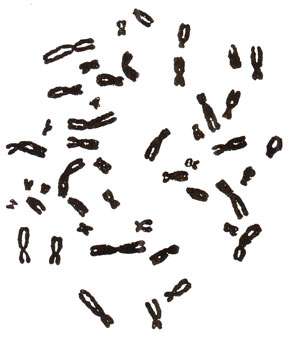Genetics / Human Genetics
Human Genetics

Fig. 24.1. A metaphase plate from leukocyte culture in human male showing 46 chromosomes, (obtained from Cytogenetics Laboratory, Zoology Department, B.H.U. Varanasi).
In earlier topics of genetics on Biocyclopedia.com, more often examples like
Drosophila were utilized to illustrate certain concepts. One would, however, like to study these concepts as illustrated by human beings, but man is rather unsuitable material for conventional genetic studies. Families are too small for dependable conclusions regarding phenotypic ratios; desired mating cannot be tried due to social implications and the life span is so long that it would take a long time in order to study even a few generations. Pedigree trees, therefore, were earlier utilized to study the genetics of various characters (see
Mendel's Laws of Inheritance) and more recently cell cultures and molecular biology techniques were used for genetic analysis. Some of these aspects of human genetics will be discussed in this section.

Fig. 24.1. A metaphase plate from leukocyte culture in human male showing 46 chromosomes, (obtained from Cytogenetics Laboratory, Zoology Department, B.H.U. Varanasi).
Support our developers

More in this section

